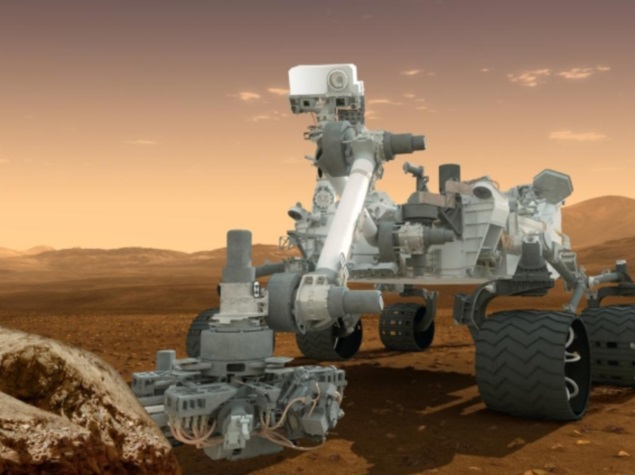- Home
- Science
- Science News
- Nasa's Curiosity Mars Rover Finds First Mineral Match on Surface
Nasa's Curiosity Mars Rover Finds First Mineral Match on Surface

"This connects us with the mineral identifications from orbit which can now help guide our investigations as we climb the slope and test hypotheses derived from the orbital mapping," said Curiosity project scientist, John Grotzinger from the California Institute of Technology, Pasadena.
Curiosity collected the powder by drilling into a rock outcrop at the base of Mount Sharp in late September.
The robotic arm delivered a pinch of the sample from a target called "Confidence Hills" into the Chemistry and Mineralogy (CheMin) instrument inside the rover.
The sample contained much more haematite than any rock or soil sample previously found during the two-year-old mission.
Haematite is an iron-oxide mineral that gives clues about ancient environmental conditions from when it was formed.
"We have reached the part of the crater, where we have the mineralogical information that was important in selection of Gale Crater as the landing site," said Ralph Milliken from Brown University.
"We are now on a path where the orbital data can help us predict what minerals we will find and make good choices about where to drill. Analyses like these will help us place rover-scale observations into the broader geologic history of Gale that we see from orbital data," he added.
Much of Curiosity's first year on Mars was spent investigating outcrops in a low area of Gale Crater called "Yellowknife Bay", near the spot where the rover landed.
The rover found an ancient lakebed. Rocks present there held evidence of wet environmental conditions billions of years ago that offered ingredients and an energy source favourable for microbial life.
The rover spent much of the mission's second year driving from "Yellowknife Bay" to the base of Mount Sharp.
The new sample is only partially oxidised and preservation of magnetite and olivine indicates a gradient of oxidation levels.
"That gradient could have provided a chemical energy source for microbes," Milliken concluded.
For the latest tech news and reviews, follow Gadgets 360 on X, Facebook, WhatsApp, Threads and Google News. For the latest videos on gadgets and tech, subscribe to our YouTube channel. If you want to know everything about top influencers, follow our in-house Who'sThat360 on Instagram and YouTube.
Related Stories
- Samsung Galaxy Unpacked 2025
- ChatGPT
- Redmi Note 14 Pro+
- iPhone 16
- Apple Vision Pro
- Oneplus 12
- OnePlus Nord CE 3 Lite 5G
- iPhone 13
- Xiaomi 14 Pro
- Oppo Find N3
- Tecno Spark Go (2023)
- Realme V30
- Best Phones Under 25000
- Samsung Galaxy S24 Series
- Cryptocurrency
- iQoo 12
- Samsung Galaxy S24 Ultra
- Giottus
- Samsung Galaxy Z Flip 5
- Apple 'Scary Fast'
- Housefull 5
- GoPro Hero 12 Black Review
- Invincible Season 2
- JioGlass
- HD Ready TV
- Laptop Under 50000
- Smartwatch Under 10000
- Latest Mobile Phones
- Compare Phones
- Redmi Turbo 4
- Vivo Y200+
- Lava Yuva 2 5G
- OnePlus Ace 5
- OnePlus Ace 5 Pro
- Oppo A5 Pro 5G
- Vivo Y29 5G
- Honor Magic 7 RSR Porsche Design
- Asus Zenbook S 14
- MacBook Pro 16-inch (M4 Max, 2024)
- Honor Pad X9 Pro
- Honor Pad V9
- boAt Enigma Gem
- boAt Enigma Daze
- Sony 65 Inches Ultra HD (4K) LED Smart TV (KD-65X74L)
- TCL 55 Inches Ultra HD (4K) LED Smart TV (55C61B)
- Sony PlayStation 5 Pro
- Sony PlayStation 5 Slim Digital Edition
- Blue Star 1.5 Ton 3 Star Inverter Split AC (IC318DNUHC)
- Blue Star 1.5 Ton 3 Star Inverter Split AC (IA318VKU)

















